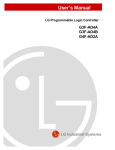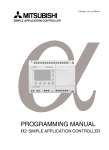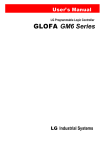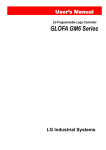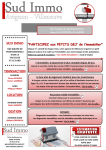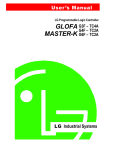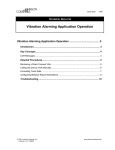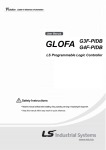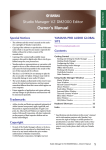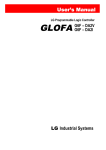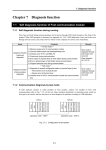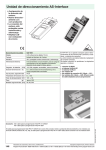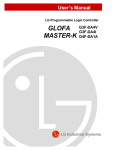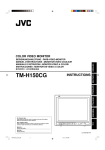Download User User`s Manual
Transcript
User’
User’s Manual
LG Programmable Logic Controller
GLOFA
G3F – AD4A
G4F – AD2A
LG Industrial Systems
CONTENTS
Chapter 1. INTRODUCTION
1.1
1.2
Features
1-1
1.1.1
G3F-AD4A 1-1
1.1.2
G4F-AD2A 1-1
Glossary 1-2
1.2.1
A-Analog Value 1-2
1.2.2
D-Digital Value
1.2.3
Analog / Digital Conversion Characteristics
1-2
1-3
Chapter 2. SPECIFICATIONS
2.1
General Specifications 2-1
2.2
Performance Specifications 2-2
2.3
Names of Parts and Functions 2-3
2.4
2.3.1
G3F-AD4A 2-3
2.3.2
G4F-AD2A 2-5
I/O Conversion Characteristics 2-6
2.4.1
G3F-AD4A I/O Characteristics
2-7
1)
Voltage Input Characteristics 2-7
2)
Current Input Characteristics 2-9
3)
Simultaneous Voltage and Current Input Characteristics 2-10
2.4.2
G4F-AD2A I/O Characteristics 2-11
1)
Voltage Input Characteristics 2-11
2)
Current Input Characteristics 2-13
3)
Simultaneous Voltage and Current Input Characteristics 2-14
2.4.3
Relations between Offset / Gain Setting and Digital Output Value 2-16
1)
Resolution 2-16
2)
Relations between Maximum Resolution and Digital Output Value
3)
Offset / Gain Setting 2-17
2-16
2.5
2-17
(1)
Offset / Gain Setting of the G3F-AD4A
(2)
Offset / Gain Setting of the G4F-AD2A 2-19
A/D Conversion Characteristics 2-21
2.5.1 Filter Processing 2-21
2.5.2
Sampling Processing (Instantaneous Value) 2-21
2.5.3
Average Processing 2-22
Chapter 3. INSTALLATION AND WIRING
3.1
Installation
3-1
3.1.1 Installation Ambience 3-1
3.1.2
3.2
Handling Precautions 3-1
Wiring 3-2
3.2.1
Wiring Precautions 3-2
3.2.2
Wiring Examples 3-3
1)
G3F-AD4A 3-3
2)
G4F-AD2A 3-4
Chapter 4. TROUBLESHOOTING
4.1
Error Code
4.1.1
4.2
4-1
Error Code Indicated by RUN LED Flickering 4-1
Troubleshooting
4-2
4.2.1
RUN LED Flickering 4-2
4.2.2
RUN LED Off 4-2
4.2.3
Digital Value Unreadable from the CPU Module 4-3
4.2.4
Sudden Digital Value Change 4-3
4.2.5
Analog and Digital Value Mismatch 4-4
4.2.6
A/D Conversion Module Hardware Fault 4-4
Chapter 5.
DIMENSIONS
5.1
G3F-AD4A Dimensions 5-1
5.2
G4F-AD2A Dimensions 5-2
Chapter 6. FUNCTION BLOCK
6.1
Insertion of the Function Block for the A/D Conversion Module on the GMWIN 6-1
6.2
Local Function Block 6-2
6.2.1 Module Initialization (G3F-AD4A: AD4INI, G4F-AD2A: AD2INI) 6-2
6.2.2 Module Reading - Array Type (G3F-AD4A: AD4ARD, G4F-AD2A: AD2ARD) 6-3
6.2.3 Module Reading - Single Type (G3F-AD4A: AD4RD, G4F-AD2A: AD2RD) 6-4
6.3
Remote Function Block 6-5
6.3.1 Module Initialization (G3F-AD4A: AD4RINI, G4F-AD2A: ADR2INI)
6.3.2 Module Reading (G3F-AD4A: ADR4RD, G4F-AD2A: ADR2RD)
6.4
6-5
6-6
Errors on Function Block 6-7
Chapter 7. PROGRAMMING
7.1
Programming for Distinction of A/D Conversion Value 7-1
7.2
Programming for Display of A/D Conversion Value and Error Code on BCD Display... 7-6
7.3 Programming for Loading the A/D Conversion Module on Remote I/O Station 7-9
SAFETY PRECAUTIONS
Be sure to read carefully the safety precautions given in data sheet and user’s manual before operating the module
and follow them.
The precautions explained here only apply to the G3F-AD4A and G4F-AD2A.
For safety precautions on the PLC system, see the GLOFA GM3/4 User’s Manuals.
A precaution is given with a hazard alert triangular symbol to call your attention, and precautions are represented
as follows according to the degree of hazard.
!
WARNING
If not provided with proper prevention, it can cause death or fatal
injury or considerable loss of property.
!
CAUTION
If not properly observed, it can cause a hazard situation to result
in severe or slight injury or a loss of property.
However, a precaution followed with
!
CAUTION
can also result in serious conditions.
Both of two symbols indicate that an important content is mentioned, therefore, be sure to observe it.
Keep this manual handy for your quick reference in necessary.
Design Precautions
!
CAUTION
Do not run I/O signal lines near to
high voltage line or power line.
Separate them as 100 mm or
more as possible. Otherwise,
noise can cause module malfunction.
Installation Precautions
!
CAUTION
Operate the PLC in the environment conditions given in the
general specifications.
If operated in other environment
not specified in the general
specifications, it can cause an
electric shock, a fire, malfunction
or damage or degradation of the
module
Make sure the module fixing projections is inserted into the module fixing hole and fixed.
Improper installation of the module can cause malfunction, disorder or falling.
Wiring Precautions
!
CAUTION
When grounding a FG terminal, be sure to provide class 3 grounding which is dedicated to
the PLC.
Before the PLC wiring, be sure to check the rated voltage and terminal arrangement for
the module and observe them correctly.
If a different power, not of the rated voltage, is applied or wrong wiring is provided, it can
cause a fire or disorder of the nodule.
Drive the terminal screws firmly to the defined torque.
If loosely driven, it can cause short circuit, a fire or malfunction.
Be careful that any foreign matter like wire scraps should not enter into the module.
It can cause a fire, disorder or malfunction.
Test Run and Maintenance
Precautions
!
!
WARNING
Do not contact the terminals
while the power is applied.
It can cause malfunction.
When cleaning or driving a terminal screw, perform them after the
power has been turned off
Do not perform works while the
power is applied, which can
cause disorder or malfunction.
CAUTION
Do not separate the module from
the printed circuit board(PCB), or
do not remodel the module.
They can cause disorder, malfunction, damage of the module
or a fire.
When mounting or dismounting
the module, perform them after
the power has been turned off.
Do not perform works while the
power is applied, which can
cause disorder or malfunction.
Waste Disposal Precautions
!
CAUTION
When disposing the module, do it as an industrial waste.
Chapter 1.
INTRODUCTION
Chapter 1. INTRODUCTION
The G4F-AD2A and the G3F-AD4A are analog/digital conversion modules for use with the GLOFA PLC GM 1/2/3/4 series
CPU module. The G4F-AD2A is used on GM4 series module, and the G3F-AD4A is used on the GM1/2/3 series module.
(Hereafter the G4F-AD2A and G3F-AD4A are called the A/D conversion module) The A/D conversion module is to convert
an analog input signal (voltage or current) from external sensors into a 16-bit signed BIN (Binary) digital value.
1.1
1.1.1
Features
G3F-AD4A
1) 16-Channel analog to digital conversion is possible with a single module.
The G3F-AD4A has 16-Channel A/D conversion capacity, with each channel selectable for voltage or current
input.
2) High resolution of 1/16000
High-resolution digital values can be obtained. Resolution setting applies to all channels.
3) A/D conversion values display.
The LED display shows a digital value or an error code as a 5-digitdecimal.
4) The number of the G3F-AD4A used on one base is unlimited.
1.1.2
G4F-AD2A
1) 4-Channel analog to digital conversion is possible with a single module.
The G3F-AD2A has 4-Channel A/D conversion capacity, with each channel selectable for voltage or current
input.
2) High resolution of 1/16000
High-resolution digital values can be obtained. Resolution setting applies to all channels.
3) The number of the G4F-AD2A used on one base is unlimited.
1-1
Chapter 1.
1.2
INTRODUCTION
Glossary
Transducer
[ Fig 1.1] Analog Value
1.2.1
[Fig 1.2]
Transducer
A-Analog Value
Analog value is a sequentially changing value such as voltage, current, temperature, speed, pressure, flux, etc.
Temperature, for example, is sequentially changing according to the time. Because this temperature is not input
on the PLC through transducer, the same analog value of DC voltage (0 to 10 V) or current (4 to 20 mA) in
accordance with the temperature should be inputted on the PLC.
1.2.2
D-Digital Value
Digital value is non-sequentially changing value written as the number like 0,
1, 2, 3. The signal of on or off is written as digital value of 0 or 1.
There are BCD value and binary value in the range of digital value.
Time
[Fig 1.3] Digital Value
Analog value isn't written directly onto the CPU. For analog input to the
CPU operation, analog converted to digital value has to be inputted onto
the CPU and for analog output, the digital value of the CPU should be
converted to analog value.
Analog input
0 to ± 10 V or
0 to ± 20 mA
Analog output
0 to ± 10 V or
0 to ± 20 mA
[Fig 1.4] PLC Processing
1-2
Chapter 1.
1.2.3
INTRODUCTION
Analog/ Digital Conversion Characteristics
1) Voltage input
Input
InputVoltage
Voltage
[Fig 1.5] A/D Conversion Characteristics (Voltage Input)
Analog/digital conversion module allows external analog input to be converted to digital value and to be operated
in the CPU. On voltage input, input of –10 V leads to digital value of 0 and 10 V to 16000.
Input of 1.25 mV is equal to digital value of 1. Therefore, input less than 1.25 mV shouldn't be converted but
ignored.
2) Current input
Analog input current
[Fig 1.6]
Current
input
Input
Current
A/D Conversion Characteristics (Current input)
On current input, input of -20 mA leads to digital value of 8000 and 20 mA to 16000. Input of 2.5 is equal to
digital value of 1. Therefore, input less than 2.5 shouldn't be converted but ignored.
1-3
Chapter 2.
SPECIFICATIONS
Chapter 2 .
2.1
SPECIFICATIONS
General Specifications
Table 2.1 shows the general specifications of GLOFA GM series.
No
1
2
3
4
Item
Operating ambient
temperature
Storage ambient
temperature
Operating ambient
humidity
Storage ambient
humidity
5
Vibration
6
Shocks
7
Specifications
Standard
0 ~ 55
-25 ~ 70
5 ~ 95%RH,
non-condensing
5 ~ 95%RH,
non-condensing
Occasional vibration
Acceleration
Amplitude
Sweep count
0.075 mm
9.8 {1G}
10 times in each
Continuos vibration
direction for
Frequency
Acceleration
Amplitude
X, Y, Z
0.035 mm
10f57 Hz
57f150 Hz 4.9{0.5G}
*Maximum shock acceleration: 147 {15G}
*Duration time :11 ms
*Pulse wave: half sine wave pulse( 3 times in each of X, Y and Z directions )
Frequency
10f57 Hz
57 f150 Hz
Square wave impulse noise
1,500 V
Electrostatic discharge
Voltage :4kV(contact discharge)
Radiated electromagnetic field
27 ~ 500 MHz, 10 V/m
Noise immunity
Severity
Level
Fast transient burst noise
Digital
Digital I/Os
I/Os
(Ue < 24 V)
All power
( Ue
Analog I/Os
modules
communication
≥
24 V)
I/Os
Voltage
8 Operating atmosphere
2 kV
1 kV
IEC 1131-2
IEC 1131-2
IEC 1131-2
IEC 801-2
IEC 1131-2
IEC 801-3
IEC 1131-2
IEC 801-4
0.25 kV
Free from corrosive gases and excessive dust
9
Altitude for use
Up to 2,000m
10
Pollution degree
2 or lower
11
Cooling method
Self-cooling
[Table 2.1 ] General specifications
REMARK
1) IEC(International Electrotechnical Commission)
: The international civilian organization which produces standards for electrical and electronics industry.
2) Pollution degree
: It indicates a standard of operating ambient pollution level.
The pollution degree 2 means the condition in which normally, only non-conductive pollution occurs.
Occasionally, however, a temporary conductivity caused by condensation shall be expected.
2-1
Chapter 2.
2.2
SPECIFICATIONS
Performance Specifications
Table 2-2 shows performance specifications of A/D conversion module.
Items
Specifications
G3F-AD4A
–5 ~ 5 VDC (input resistance 560)
Voltage
–10 ~ 10 VDC (input resistance 560)
Current
Analog
input
DC –20 ~ 20 mA (input resistance 250)
*. Select with the Input conversion
switch on the side of the module
Voltage/Current selection (on: current, off: voltage)
*. When current input is used, set the
Input range switch to V1 / I.
Digital output
Maximum
resolution
G4F-AD2A
*. Select in accordance with the Input terminals.
*. Connect the V terminal with the I terminal on
the use of current input.
*. 16-bit (data: 14bit)signed binary
*. May be set per channel by setting output data
"0": -192 to 16191
"1": -8192 to 8191
-5 ~ 5 VDC
0.625 mV (1/16000)
-10 ~ 10 VDC
1.25 mV (1/16000)
DC -20 ~20 mA
0.0025 mA (1/16000)
0.5% or lower (accuracy to full scale)
Overall Accuracy(%)
Maximum conversion speed
(ms/channel)
(0.3% at ambient temperature 25)
3.0
Maximum absolute input
Number of analog input point
Isolation
5.0
Voltage(V):12, Current (mA):25
16 channels/module
4 channels/module
Between input terminals and PLC: Photo coupler isolation
(Between channels : Non-isolated)
Terminals connected
38-point terminal block
20-point terminal block
Internal current consumption(A)
0.7 A
0.4 A
Weight (g)
630
360
LED Display
Digital output value or
Error code is displayed
-
[Table 2.2] Performance Specifications
! CAUTION
The factory set value to A/D conversion module has been in the range of the from -10 to 10 VDC, and
in accordance with it, offset / gain values have already been set.
2-2
Chapter 2.
SPECIFICATIONS
2.3 Names of Parts and Functions
The names of parts and functions of the A/D conversion module are shown as below.
2.3.1
G3F-AD4A
The names of parts and functions of the A/D conversion module are shown
2-3
Chapter 2.
SPECIFICATIONS
No
Descriptions
RUN LED
Indicates the operating status of the G3F-AD4A
(1) On
: Normal operation
(2) Flicker : An error has occurred. (For more information, see the General Section 4.1)
(3) Off
: DC 5 V power-off or G3F-AD4A module fault.
LED Display
(1) Digital value indication
- Indicates a digital value of the channel specified by the channel switch.
- Indicates a digital value as a 5-digit decimal (Display range: -8192 to 8181 or -192 to 16191)
- Updates a digital value in 0.6sec
(2) Error number indication
E r
r
The one least significant digit indicates error code.
(3) Stop indication
- Indicates no channel specified by the channel switch.
Offset Trimmer
Used to make micro adjustment of an offset value.
Gain Trimmer
Used to make micro adjustment of a gain value.
Channel switch
- Used to set the channel of which digital value is displayed.
- Setting range : 0 to F
Input range switch
- On factory set, the voltage range has to be set to from -10 to 10 VDC.
(1) Set to voltage
V1 : Voltage range -5 ~ 5 VDC
V2 : Voltage range -10 ~ 10 VDC
(2) Set to current
I : Current range -20 ~ 20 mA
: Unusable
Input select switch
(1) Used to select the analog input(voltage or current input) of each channel
-Set to OFF to use voltage input.
-Set to ON to uses current input.
(2) On factory set, it has to be set to voltage input condition. (Every Dip Switch is off.)
2-4
Chapter 2.
2.3.2
SPECIFICATIONS
G4F-AD2A
This section shows the names of parts and functions of G4F-AD2A module.
No
Descriptions
No
Descriptions
① RUN LED
④ GAIN switch
Indicates the operating status of the G4F-AD2A.
Adjust upward, and the analog input value of
Normal mode: channel switch's setting range: 4 to F
corresponding channels is stored as a gain value.
- ON
: Normal operation.
⑤ Input range select switch
- Flicker : An error has occurred.
- OFF : DC5V power-off or G3F-AD4A module fault.
Switch
Analog input
Test mode: channel switch's range: 0 to 3
- Flicker(per 1.0sec) : No operation of offset/gain switch.
-10 ~ 10 VDC
- ON
: Offset/gain switch adjusted upward.
Voltage
- Flicker(per 0.2sec) : offset/gain setting error.
-5 ~ 5 VDC
② Offset switch
Adjust upward, and the analog input value of corresponding
channels is stored as an offset value.
③
Channel switch for the test mode
Corresponding channels will be selected in the adjustment of
offset/gain value. (Valid range: 0 to 3 )
2-5
Current
-20 ~ 20 mA
* Don’t put the input switch on
* It leads to malfunction.
or
Chapter 2.
SPECIFICATIONS
2.4 I/O Conversion Characteristics
Input / Output (hereafter I/O) conversion characteristics are expressed by the angle of the line connecting the
offset value and gain value used to convert the analog signals, input to the PLC into digital values.
The I/O conversion characteristics of the A/D conversion module are shown as below.
G3F-AD4A
Practical analog input range
Gain value
Digital
Output
Value
Offset value
Range: - 10 ~ 10 VDC
Range: - 5 ~ 5 VDC
Range: - 20 ~ 20 mA
Analog Input
G4F-AD2A
Practical analog input range
Gain value
Digital
Output
Value
Offset value
Range: - 10 ~ 10 VDC
Range: - 5 ~ 5 VDC
Range: - 20 ~ 20 mA
Analog Input
[Fig 2.1]
I/O Conversion Characteristics
2-6
Chapter 2.
2.4.1
SPECIFICATIONS
G3F-AD4A I/O Characteristics
The G3F-AD4A allows voltage or current input to be selected per channel by the input select switch.
Offset / gain setting is performed for 16 channels in block.
1) Voltage Input Characteristics
For voltage input, the input select switch of each channel is set to "off".
Position of Input select switch
- Off : Voltage
(On the left side of the Module)
Channel number
a) Range : -10 ~ 10 VDC
-The analog input range switch has to be set to downward (V2).
Position of Analog input range switch
V1/ I (–5~5 VDC select)
V2
(–10~10 VDC select)
<On the front side of the module>
Digital
Output
Value
0V 1V
-10.24 V -10 V
5V
10 V 10.24 V
Analog Input (Voltage)
Analog input (voltage)
-The digital output value according to voltage input characteristics will be shown as below.
Digital
output
range
-10 V
0V
1V
5V
10 V
-192~16191
0
8000
8800
12000
16000
-8192~8191
-8000
0
800
4000
8000
Analog input voltage
2-7
Chapter 2.
SPECIFICATIONS
b) Range: -5 ~ 5 VDC
-The analog input range switch has to be set upward (V1/ I)
The way to set analog input range switch
V1/ I (–5~5 VDC select)
V2 (–10~10 VDC select)
<The front side of the module>
Digital
Output
Value
-5.12 V –5 V
0V 1V
3V
5 V 5.12 V
Analog Input Value (Voltage)
-The digital output value according to voltage input characteristics will be shown as below.
Digital
output
range
-5 V
0V
1V
3V
5V
-192~16191
0
8000
9600
12800
16000
-8192~8191
-8000
0
1600
4800
8000
Analog input voltage
2-8
Chapter 2.
SPECIFICATIONS
2) Current Input Characteristics
- For current input, the input select switch of each channel is set to "on".
Analog input range switch has to be set upward (V1/ I).
Input select switch position
Analog input range switch position
V1/ I (DC –20~20mA)
V2
(Current input disable)
Digital
Output
Value
9600
-20.48 m-20mA
0mA 4mA
12mA
20mA 20.48mA
Analog Input Value (Voltage)
The digital output value according to current input characteristics will be shown as below.
Analog input current
Digital output
range
-20 mA
0 mA
4 mA
12 mA
20 mA
-192~16191
0
8000
9600
12800
16000
-8192~8191
-8000
0
1600
4800
8000
2-9
Chapter 2.
SPECIFICATIONS
3) Simultaneous Voltage and Current Input Characteristics
For simultaneous voltage and current input, the input conversion switch of each channel is set to corresponding
voltage and current range.
Analog input switch has to be set upward (V1/ I).
Ex) Voltage input range: 0 to 7
Current input range: 8 to 15
Input select switch position
Analog input range switch position
V1/ I
Current selection
Voltage selection
Voltage:-5~5 VDC
Current:DC-20~20 mA
V2
- For simultaneous voltage and current input, voltage input range has to be set only to the range [-5 ~ 5 VDC].
8191
8000
Digital
Output
Value
0
-8000
-8191
Analog Input
- Simultaneous voltage and current input characteristics lead to digital output value as below.
Analog input
-5 V
0V
1V
3V
5V
-20 mA
0 mA
4 mA
12 mA
20 mA
-192~16191
0
8000
9600
12800
16000
-8192~8191
-8000
0
1600
4800
8000
Digital output range
2 - 10
Chapter 2.
2.4.2
SPECIFICATIONS
G4F-AD2A I/O Characteristics
1) Voltage Input Characteristics
- The G4F-AD2A is capable of selecting voltage/current and adjusting offset/gain for each channel.
- For voltage input, the input conversion switch may be set to the range such as from-10 to 10 VDC, or
from -5 to 5 VDC.
a)
-10 ~ 10 VDC
Position of input range switch
Turn switch 1 on and switch 2 off.
(On the left side of the module)
Offset value : 5V
Gain value :0 V
Offset value : 10V
Gain value :0
Digital
Output
Value
Offset value :
0V
Gain value :5 V
-10.24 V –10 V
-5 V
0V
5V
10 V 10.24 V
Analog Input (Voltage)
- When offset/gain setting is changed, digital output value to voltage input characteristics are as below.
Section
Ex 1
Ex 2
Ex 3
Ex 1
Ex 2
Ex 3
Digital
output
range
-192
~
16191
-8192
~
8191
Analog input voltage
Offset
value
Gain
value
- 10 V
-5V
0V
3V
5V
10 V
-5 V
0V
-192
0
8000
12800
16000
16191
-10 V
0V
0
4000
8000
10400
12000
16000
0V
5V
-192
-192
0
4800
8000
16000
-5 V
0V
-8192
-8000
0
4800
8000
8191
-10 V
0V
0
-4000
0
2400
4000
8000
0V
5V
-8192
-8192
-8000
-3200
0
8000
2 - 11
Chapter 2.
SPECIFICATIONS
b)
-5 ~ 5 VDC
Position of input range switch
Turn switch 1 off and switch 2 on.
(On the left side of the module)
Offset value : -5 V
Gain value :0 V
Digital
Output
Value
Offset value : 0V
Gain value :2.5 V
Offset value : 1V
Gain value :3 V
-5.12 V –5 V
-2.5 V
0V 1V
2.5 V
5 V 5.12 V
Analog Input (Voltage)
- When offset/gain setting is changed, digital output value to voltage input characteristics are shown as below.
Section
Ex 1
Ex 2
Ex 3
Ex 1
Ex 2
Ex 3
Digital
output
range
-192
~
16191
-8192
~
8191
Analog input voltage
Offset
value
Gain
value
-5V
0V
1V
3V
5V
-5 V
0V
0
8000
9600
12800
16000
0V
2.5 V
-192
0
3200
9600
16000
1V
3V
-192
-192
0
8000
16000
-5 V
0V
-8000
0
1600
4800
8000
0V
2.5 V
-8192
-8000
-4800
1600
8000
1V
3V
-8192
-8192
-8000
0
8000
2 - 12
Chapter 2.
2)
SPECIFICATIONS
Current Input Characteristics
Offset value : -20 mA
Gain value :0 mA
Ex3 Offset value:4mA
Offset value : 0mA
Gain
value:12mA
Digital
Output
Value
Gain value :10mA
Offset value : 4mA
Gain value :12mA
-20mA
0mA
4mA 10mA 12mA
20mA
Analog Input (Current)
- When offset/gain setting is changed, digital output value to current input characteristics are shown as below.
Sectio
n
Ex 1
Ex 2
Ex 3
Ex 1
Ex 2
Ex 3
Digital
output
range
-192
~
16191
-8192
~
8191
Analog input current
Offset
value
Gain
value
- 20 mA
0 mA
4 mA
10 mA
12 mA
20 mA
-20 mA
0 mA
0
8000
9600
12000
12800
16000
0 mA
10 mA
-192
0
3200
8000
9600
16000
4 mA
12 mA
-192
-192
0
6000
8000
16000
-20 mA
0 mA
-8000
0
1600
4000
4800
8000
0 mA
10 mA
-8192
-8000
-4800
0
1600
8000
4 mA
12 mA
-8192
-8192
-8000
-2000
0
8000
2 - 13
Chapter 2.
3)
SPECIFICATIONS
Simultaneous Voltage and Current Input Characteristics
-When voltage and current are input simultaneously, the input range switch of the left side of the module has
to be set to the range of from -5 to 5 VDC. (Switch 1 turns Off, Switch 2 turns On )
Ex) Voltage input channel : 0,
Current input channel : 1
Input range select switch
(on the left side of module)
Terminal connection
voltage input (channel 0)
current input (channel 1)
-5 ~ 5 VDC
-10 ~ 10 VDC
-When voltage and current are input simultaneously, voltage input range has to be set only to the range from
-5 to 5 VDC.
Digital
Output
Value
Analog Input
2 - 14
Chapter 2.
SPECIFICATIONS
-When offset/gain setting is changed, digital output value to voltage/current input characteristics are shown
as below.
Section
Ex 1
Ex 2
Ex 3
Ex 1
Ex 2
Ex 3
Digital
output
range
-192
~
16191
-8192
~
8191
Analog input
Offset value
(Voltage
/ Current)
Gain value
(Voltage
/ Current)
-5 V
0V
1V
2.5 V
3V
5V
- 20 mA
0 mA
4 mA
10 mA
12 mA
20 mA
-5 V / -20 mA
0 V / 0 mA
0
8000
9600
12000
12800
16000
0 V / 0 mA
2.5 V / 10 mA
-192
0
3200
8000
9600
16000
1V / 4 mA
3 V / 12 mA
-192
-192
0
6000
8000
16000
-5 V / -20 mA
0 V / 0 mA
-8000
0
1600
4000
4800
8000
0 V / 0 mA
2.5 V / 10 mA
-8192
-8000
-4800
0
1600
8000
1 V / 4 mA
3 V / 12 mA
-8192
-8192
-8000
-2000
0
8000
! Caution
1. When digital output is set to the range of -192 to 16191, despite a analog input more than the range of -192 to
16191, Digital output value is set to-192 or 16191.
When digital output is set to the range of –8192 to 8191, despite a analog input more than the range of -8192
or 8191, digital output value is set to -8192 or 8191.
2. Do not apply 15 V /25 mA or more. This will damage the module due to a heat rise.
3. Set an offset/gain value on the G4F-AD2A to the range that gain value is more than offset value, or you won't
get an accurate digital output.
2 - 15
Chapter 2.
SPECIFICATIONS
2.4.3
Relations between Offset/gain Setting and Digital Output Value
1)
Resolution
Resolution is determined as below formulas.
(1) Voltage input
Resolution
=
Gain value
=
Offset value
8000
Ex) Gain value : 0 V
Resolution
-
✕
1000 (mV)
Offset value : - 10 V
0 – ( - 10 )
✕
8000
1000 mV =
1.25 mV
(2) Current input
Resolution
=
Gain value
2)
=
Offset value
8000
Ex) Gain value : 0 mA
Resolution
-
✕
1000 (µA)
Offset value : - 20 mA
0 – ( - 20 )
✕
8000
1000 µA
=
2.5 µA
Relations between Maximum Resolution and Digital Output Value
On the occasion of calculating, as follows, by offset/gain setting, digital output value 1 at a time doesn't
increase or decrease.
Gain value
8000
Offset value
<
Resolution
2 - 16
Chapter 2.
3)
SPECIFICATIONS
Offset / Gain Setting
(1) Offset/gain setting of the G3F-AD4A
a) Offset/gain sets procedure.
: Offset/gain setting is performed for 16 channels in block.
Set the channel switch to No 0
Write a program for the A/D conversion into the memory
of the CPU module, and operate the CPU module.
Digital value and channel
display setting
After making programs of
used channel, operate the
CPU module
Apply offset voltage (or current) to input terminal of channel 0.
Offset micro adjustment
Adjust the offset trimmer until the digital value on the LED
display corresponds to the offset value.
Apply gain voltage (or current) to input terminal of channel 0.
Gain micro adjustment
Adjust the gain trimmer until the digital value on the LED
display corresponds to the gain value.
Offset/gain micro adjustment has been completed
2 - 17
Chapter 2.
SPECIFICATIONS
b) I/O characteristics in accordance with offset/gain setting
Digital Output Value
No
Input
range
➀
DC–
10~10
V
➁
DC
–5~5V
Digital
output
range
-192
~
16191
-192
~
16191
Offse
t
value
Gain
value
Resolut
ion
0V
10V
1.25
mV
0V
5V
0.625
mV
Analog input value (V)
5.000
~
5.00125
5.000
~
5.000625
5.00625
~
5.00125
5.00125
~
5.0025
5.00125
~
5.001875
5.001875
~
5.0025
5.0025
~
5.00375
5.0025
~
5.003125
5.00375
~
5.005
5.003125
~
5.00375
5.00375
~
5.004375
5.004375
~
5.005
Voltage input and digital output value
Digital output value
No
Input
range
Digital
output
range
Offset
value
Gain
value
Resoluti
on
➀
DC–
20~20
mA
-192
~
16191
0
mA
20
mA
0.0025
mA
Analog input value (mA)
10.000
~
10.0025
10.0025
~
10.0050
10.0050
~
10.0075
Current input and digital output
value
2 - 18
10.0075
~
10.0100
10.0100
~
10.0125
10.0125
~
10.0150
Chapter 2.
SPECIFICATIONS
(2) Offset/gain Setting of the G4F-AD2A
a) Offset/gain Setting Procedure
Set offset / gain values for each channel.
Set the channel select switch for test mode to channel 0.
: RUN LED flickering per 1sec
Write a program for the A/D conversion module to the memory of the
CPU module. Operate the CPU module.
Test mode
After making used
channel program,
operate the CPU module.
Apply offset voltage (or current) to input terminal of channel 0.
Offset value adjustment
Adjust the offset switch to the upward direction so that an offset value
corresponding to the channel 0 can be set.
: Adjustment of the offset trimmer upward makes RUN LED on.
Apply gain voltage (or current) to input terminal of channel 0.
Gain value adjustment
Adjust the gain switch to the upward direction so that a gain value
corresponding to the channel 0 can be set.
: Adjustment of the gain trimmer upward makes RUN LED on
Setting has completed for all used channels 0 to 3.
Offset/gain micro adjustment has completed
: Set the channel selects switch to one of channels 4 to F.
(Normal Mode state)
REMARK
(1) Set offset/gain value within practical input range.
(2) Offset/gain value is stored in the G4F-AD2A and remains after power-off.
(3) Set offset/gain value to the range of from-10 to 10 volts DC or from –20 to 20 mA.
However, if this range is exceeded, the resolution and accuracy will be impaired.
(4) At the change of grounding position in the *5 of 3.2.2, be sure to restart offset/gain value from the beginning
2 - 19
Chapter 2.
SPECIFICATIONS
b) Input/output Characteristics According to Offset/gain Setting
Digital output value
No
➀
➁
➁
Input
range
DC
-10~
10 V
DC
-5
~5V
DC
-5
~5V
Digital
output
range
-192
~
16191
-192
~
16191
-192
~
16191
Offset
value
Gain
value
Resolut
ion
0V
10 V
1.25
mV
0V
5V
0.625
mV
1V
2.5 V
0.125
mV
Analog input value (V)
5.000
~
5.00125
5.000
~
5.000625
5.00625
~
5.00125
5.00125
~
5.0025
5.00125
~
5.001875
5.0025
~
5.00375
5.001875
~
5.0025
4.000
~
4.000625
5.0025
~
5.003125
5.00375
~
5.005
5.003125
~
5.00375
4.000625
~
4.00125
5.00375
~
5.004375
5.004375
~
5.005
4.00125
~
4.001875
* ➂ is over the maximum resolution, so digital value 1 at a time doesn't increase or decrease.
Voltage input and digital output value
Digital output value
No
➀
➁
Input
range
DC
-20~20
mA
DC
-20~20
mA
Digital
output
range
-192
~
16191
-192
~
16191
Offset
value
Gain
value
Resolution
-20
mA
0
mA
0.0025
mA
4
mA
12
mA
0.001
mA
Analog input value (mA)
10.000
~
10.0025
10.0025
~
10.0050
16.000
~
16.0025
10.0050
~
10.0075
10.0075
~
10.0100
10.0100
~
10.0125
10.0125
~
10.0150
16.0025
~
16.0050
* ➁ is over the maximum resolution so digital value 1 at a time doesn't increase or decrease.
Current input and digital output value
2 - 20
10.0150
~
10.0175
16.0050
~
16.0075
10.0175
~
10.0200
10.0200
~
10.0225
Chapter 2.
SPECIFICATIONS
2.5 A/D Conversion Characteristics
Filter processing
Sampling (instantaneous value) processing
Average processing
Number average processing
Time average processing
A/D conversion
2.5.1
Filter Processing
Filter processing noise or the quick change of input value helps to use a stable digital value compared with
analog value.
PVfn = ( 1 - α ) × PVn + α PVfn – 1
PVfn
: present filter output value
PVn
: present A/D conversion value
PVfn-1
: previous filter output value
α
: Filter constant(the range: 0.01 to 0.99)
Filter constants used here are 1 to 99.
Ex) When analog value is changed in the sequence like -10V, -5V, 0V, and 5V, filter output is shown as below.
Value of 0.01
0.5
0.99
0
0
0
Filter output value
3960
7960
2000
5000
40
120
11960
8500
239
Remarks
leaning to the previous value by 1 %
leaning to the previous value by 50 %
leaning to the previous value by 99 %
That is, filter disable allows present A/D conversion value to be displayed and filter enable allows A/D
conversion value to be displayed by filter constant according to the relative importance between present
A/D conversion value and previous.
2.5.2
Sampling Processing (Instantaneous Value)
This is general A/D conversion processing. In other words, analog input value has to be converted to digital
value even without average processing. Sampling period for writing digital value to the memory is changed
according to the number of used channels.
(Process time) =
(Number of channels) × Conversion speed
Ex) When 3 channels are used.
- G3F – AD4A : 3 × 3(Conversion speed) = 9 (ms)
- G4F – AD2A : 3 × 5(Conversion speed) = 15 (ms)
Sampling processing means, when average processing isn't used, analog input value is to be converted to
digital value in direct.
2 - 21
Chapter 2.
SPECIFICATIONS
2.5.3
Average Processing
1) The Cause of Average Processing
Average processing of noise or abnormal analog input is used to stabilize system control.
2) Kinds of Average Processing
There are kinds of average processing, which are time average and number average.
(1) Time Average Processing
a) Setting Range
G3F-AD4A : 96 to 12,000 (ms)
G4F-AD2A : 40 to 20,000(ms)
b) On the time average processing, the number of average processing within the Set time is
determined according to the number of channels.
Set time
Processing number =
Used channels
Conversion speed
Ex) Used channels : 4,
Set time : 120 ms
G3F-AD4A : 120(4
3) = 10 count
G4F-AD2A : 120(4
5) = 6 count
c) When Set time divided by(Number of used channel
Conversion speed) makes the residue occur,
the processing number will be [ { average processing number ( the number of used
channel conversion speed) } + 1] by raising the residue.
Ex) Used channels: 4,
Set time : 200 ms
G3F-AD4A : 150(4
3) = 12 count + remain
6
13 count
G4F-AD2A : 150(4
5) = 7 count + remain
10
13 count
(2) Number Average Processing
a) Setting range
G3F - AD4A :
2 to 4000 (count)
G4F - AD2A :
2 to 4000 (count)
b) Number average processing period for writing digital value to the buffer memory is changed
according to the number of channels.
Processing time = Setting times
Number of enabled channels
Conversion speed
Ex) Used channels: 4, Average processing time: 50 count.
G3F - AD4A : 50
4
3 = 600 ms
G4F - AD2A : 50
4
5 = 1000 ms
2 - 22
Chapter 3.
INSTALLATION AND WIRING
Chapter 3.
3.1
INSTALLATION AND WIRING
Installation
3.1.1
Installation Ambience
This module has high reliability regardless of its installation ambience. But be sure to check the
following for system in higher reliability and stability.
1)
Ambience Requirements
Avoid installing this module in locations, which are subjected or exposed to:
- Water leakage and dust a large amount of dust, powder and other conductive power, oil mist,
salt, of organic solvent exists.
- Mechanical vibrations of impacts are transmitted directly to the module body.
- Direct sunlight.
- Dew condensation due to sudden temperature change.
- High or low temperatures (outside the range of 0-55)
2)
Installing and Wiring
- During wiring or other work, do not allow any wire scraps to enter into it.
- Install it on locations that are convenient for operation.
- Make sure that it is not located near high voltage equipment on the same panel.
- Make sure that the distance from the walls of duct and external equipment be 50 mm or more.
- Be sure to be grounded to locations that have good noise immunity.
3.1.2
Handling Precautions
From unpacking to installation, be sure to check the following:
1) Do not drop it off, and make sure that strong impacts should not be applied.
2) Do not dismount printed circuit boards from the case. It can cause malfunctions.
3) During wiring, be sure to check any foreign matter like wire scraps should not enter into the upper
side of the PLC, and in the event that foreign matter entered into it, always eliminate it.
4) Be sure to disconnect electrical power before mounting or dismounting the module.
3-1
Chapter 3.
INSTALLATION AND WIRING
3.2 Wiring
3.2.1
Wiring Precautions
1) Separate AC and external input signal of A/D conversion module wiring not to be affected by surge
or induced noise in the AC.
2) External wiring has to be at least AWG22(0.3) and be selected in consideration of operating
ambience and/or allowable current.
3) Separate wiring from devices and/or substances generating intense heat, and oil not to make shortcircuit which leads to damage and/or mis-operation.
4) Identify the polarity of terminal block before external power supply is made connected.
5) Separate external wiring sufficiently from high voltage and power supply cable not to cause induced
failure and/or malfunction.
6) Don't put the power cable in front of the LED display
(In order to read the digital value on the LED correctly)
3-2
Chapter 3.
INSTALLATION AND WIRING
3.2.2
Wiring Examples
1)
G3F-AD4A
(1)
Voltage Input
Signal source –10 ~ 10 VDC
Input select switch
Input range switch
Input select switch
Input range switch
(2) Current Input
Signal source –20 ~ 20 mA
*1 For the cable, use a two-core twisted shielded wire.
*2 The SLD terminal and AGND terminal has to be connected.
*3 When there is much noise, the SLD terminal and FG terminal has to be grounded.
*4 Input resistance has been shown.
*5 When there is much noise, FG of the power supply module must be grounded.
3-3
Chapter 3.
INSTALLATION AND WIRING
2)
G4F-AD2A
(1)
Voltage Input
Signal source –10 ~ 10 VDC
Input range switch
(2)
Current Input
Signal source –20 ~ 20 mA
Input range switch
*1 For the cable, use a two-core twisted shielded wire.
*2 The SLD terminal and AGND terminal has to be connected.
*3 When there is much noise, the SLD terminal and FG terminal has to be grounded.
*4 Input resistance has been shown.
*5 When there is much noise, FG of the power supply module must be grounded.
3-4
Chapter 4.
TROUBLESHOOTING
Chapter 4.
TROUBLESHOOTING
This section shows the descriptions of the error code and troubleshooting during use of the A/D conversion module.
4.1
Error Code
4.1.1
Error Code Indicated by RUN LED Flickering
Errors occurring during RUN LED flickering are shown as below.
RUN LED
Descriptions
LED display of the
G3F-AD4A
flicker(per 0.1sec)
WDT error
Err 1
System error
Err 0
Buffer memory error
Err 2
Offset / gain setting error
-
flicker(per 0.2sec)
4-1
Remarks
Chapter 4.
TROUBLESHOOTING
4.2 Troubleshooting
4.2.1
RUN LED Flickering
RUN LED flickering
G4F – AD2A only
RUN LED flickering (per 0.1 sec)?
The channel switch has been set to 03(Test
Yes
mode).
:Set the channel switch to 4F(Normal mode).
No
RUN LED flickering (per 0.2sec)?
Yes
Offset/gain setting has been at incorrect value area.
: Correct Offset/gain setting value.
No
See the Section 4.2.6
4.2.2
RUN LED Off
RUN LED off
Correct installation of the A/D conversion
module on the base?
Yes
Install the A/D conversion module on the base
correctly.
No
Capacity sufficient for the power supplies
module on the base?
Yes
Calculate current consumption and replace the
power supply module
No
If the A/D conversion module on which
errors occur is substituted for new one,
normal operation?
Yes
See the Section 4.2.6
No
The error is occurring on other than the
A/D conversion module.
For more information, see the CPU module
user's manual.
4-2
Chapter 4.
TROUBLESHOOTING
4.2.3
Digital Value Unreadable from the CPU Module
Digital value unreadable from CPU?
Channel
enabled
forfor
A/D
conversion?
Channel
enabled
A/D
conversion?
See the available channel number and enable the
correct channel.
Yes
No
Cables connected without fault?
Yes
See the Section 3.2.2
No
See the Section 4.2.6
4.2.4 Sudden Digital Value Change
Sudden digital value change.
AGND are connected with SLD terminal?
Connect AGND with SLD terminal
Yes
No
The FG terminal of the A/D conversion
module is connected with the FG terminal of
the power supply module?
Connect the FG terminal of the A/D
conversion module with the FG terminal of
the power supply module
Yes
No
See the Section 4.2.6
4-3
Chapter 4.
TROUBLESHOOTING
4.2.5
Analog and Digital Value Mismatch
Analog and digital value mismatch.
Offset/gain setting at correct positions?
Correct the offset / gain setting.
Yes
No
Analog input switch setting in accordance
with the analog input of the channels?
See the correct setting positions and correct.
Yes
No
Correct analog input wiring?
See the Section 3.2.2
Yes
No
See the Section 4.2.6
4.2.6
A/D Conversion Module Hardware Fault
A/D conversion module hardware fault.
Please contact our representatives or the service station with fault
details.
4-4
Chapter 5.
DIMENSIONS
Chapter 5.
5.1
DIMENSIONS
G3F-AD4A Dimensions
5-1
Chapter 5.
5.2
DIMENSIONS
G4F-AD2A Dimensions
5-2
Chapter 6.
FUNCTION BLOCK
CHAPTER 6.
FUNCTION BLOCK
This shows function block for A/D conversion module on the GMWIN.
A kind of function block is as follows.
No
G3F-AD4A
G4F-AD2A
Function
Local
Remote
Local
Remote
1
AD4INI
ADR4INI
AD2INI
ADR2INI
Initializing module
2
AD4ARD
ADR4RD
AD2ARD
ADR2RD
Reading A/D conversion value(array Type)
3
AD4RD
-
AD2RD
-
Reading A/D conversion value(Single Type)
6.1 Insertion of the Function Block for A/D Conversion Module on the GMWIN
Function Block is inserted on the execution of the GMWIN according to following procedure.
Function block can be inserted only in the open condition of the Project.
Project(P)
select
Library Insert(I)
G3F – AD4A
1. Special.3fb
. AD4INI
. AD4ARD
. AD4RD
2. Remote3.3fb
. ADR4INI
. ADR4RD
3. Remote4.3fb
. ADR2INI
. ADR2RD
G4F – AD2A
1. Special.4fb
. AD2INI
. AD2ARD
. AD2RD
2. Remote4.4fb
. ADR2INI
. ADR2RD
3. Remote3.4fb
. ADR4INI
. ADR4RD
Local
Function block
Inserting
Remote GM3
Function block
Inserting
Remote GM4
Function block
Inserting
Local
Function block
Inserting
Remote GM4
Function block
Inserting
Remote GM3
Function block
Inserting
6-1
Chapter 6.
FUNCTION BLOCK
6.2 Local Function Block
6.2.1
Module Initialization : (G3F-AD4A: AD4INI, G4F-AD2A:AD2INI)
Module Initialization function block is a program for the use in setting base location number and the slot
location number of an A/D conversion module, specifying an available channel enable, a data type for
A/D conversion, filter processing data, and average processing data.
Function
block
I/O
Input
Variable
REQ
BOOL
BASE
USINT
SLOT
USINT
CH
BOOL
[Array]
*note1
DATA
TYPE
BOOL
[Array]
*note1
FILT
_EN
FILT
_VAL
AVG_
EN
AVG_
EN
Output
Data
type
BOOL
[Array]
*note2
USINT
[Array]
*note2
BOOL
[Array]
*note2
BOOL
[Array]
*note2
NUM/
TIME
USINT
[Array]
*note2
DONE
BOOL
STAT
USINT
ACT
BOOL
[Array]
*note1
Descriptions
Function Block Execution Request Area
- The execution of function block initialization is requested in this area.
- If the status to be connected with this area is satisfied on the program operation
and input condition changes from low(0) to high(1), function block initialization for
the module is executed.
Base Location Number Area
- The base No. on which A/D conversion module is mounted is written on this area.
- Setting range : GM1 series( 0 to 31 ), GM2 series( 0 to 7), GM3/4 series( 0 to 3)
Slot Location Number Area
- The slot No. on which A/D conversion module is mounted is written on this area.
- Setting range: 0 to 7
Available Channel Specification Area
- Available channels are specified in this area.
- Enabled channels are specified to 1 and disabled channels are specified to 0.
Output Data Type Specification Area
- Output digital data type for each channel is specified in this area.
- 0 is for the range of -192 to 16191.
- 1 is for the range of -8192 to 8191.
Filter Processing Enable Specification Area
- 0 is for the sampling processing.
- 1 is for the filter processing.
Filter Constant Setting Area
- Setting range: 1 to 99
Average Processing Enable Specification Area
- 1 is for the average processing.
- 0 is for the sampling process.
Average process Type Specification Area
- 1 is for the time average.
- 0 is for the number average.
Average Number or Average Time Set Area
- The number or time is set in accordance with the average process type
specified on the AVG-SEL.
- Average number :2 to 4000 (count)
- Average time : G3F-AD4A: 96 to12,000(ms), G4F-AD2A: 40 to 20,000(ms)
Function Block Execution Complete Area
- When function block initialization is executed with no error, 1 is written and until
next execution, 1 is continuing. When error occurs, 0 is written and operation come
to stop.
Error Code Display Area
- When error occurs during function block initialization, the error code number is
written.
- Error code is referred to GM Section 1.4.
Channel Operation Display Area
- The channel specified after executing the function block initialization with no error
is right, 1 is written and, on the non-specified channel, 0 is written.
REMARK
*note 1 : The number of array is G3F-AD4A of 16 and G4F-AD2A of 4 .
*note 2 : The number of array is 4.
On the G3F-AD4A, the element number (0) is specified to channel 0, 1, 2, 3 in block,
the element number (1) is specified to channel 4, 5, 6, 7, in block.
the element number (2) is specified to channel 8, 9, 10, 11 in block.
the element number (3) is specified to channel 12, 13, 14, 15 in block.
On the G4F-AD2A, the element numbers means the channel ones.
6-2
Chapter 6.
FUNCTION BLOCK
6.2.2 Module Reading-Array Type : (G3F-AD4A: AD4ARD, G4F-AD2A: AD2ARD)
Array type of function block for reading the module is performed for every channel in block and the specified
channels are used to read output variable of data displayed from A/D conversion digital value.
Function
Block
I/O
Variable
Data
type
Input
Descriptions
REQ
BOOL
Function Block Execution Request Area
- The execution of function block reading is requested in this area.
- If the status to be connected with this area is satisfied on the program operation
and input condition changes from low(0) to high(1), function block initialization for
the module is executed.
BASE
USINT
Base Module Location Number Area
- The base No. on which A/D conversion module is mounted is written on this area.
- Setting range : GM1 series( 0 to 31 ), GM2 series( 0 to 7), GM3/4 series( 0 to 3)
SLOT
USINT
Slot Location Number Area
- The slot No. on which A/D conversion module is mounted is written on this area.
- Setting range: 0 to 7
CH
BOOL
[Array]
*note1
Available Channel Specification Area
- Available channels are specified in this area.
- Enabled channels are specified to 1 and disabled channels are specified to 0.
DONE
BOOL
Function Block Execution Complete Area
- When function block reading is executed with no error, 1 is written and until next
execution, 1 is continuing. When error occurs, 0 is written and operation come to
stop
STAT
USINT
Error Code Display Area
- When error occurs during function block reading, the error code number is written.
- Error code is referred to GM Section 1.4.
ACT
BOOL
[Array]
*note1
Channel Operation Display Area
- The channel specified after executing the function block read with no error is
right, 1 is written and, on the non-specified channel, 0 is written
DATA
INT
[Array]
*note1
A/D Conversion Value Output Area
output
REMARK
*note 1: The number of array is G3F-AD4A of 16 and G4F-AD2A of 4 .
6-3
Chapter 6.
FUNCTION BLOCK
6.2.3
Module Reading - Single Type : (G3F-AD4A :AD4RD, G4F-AD2A:AD2RD)
Single type of function block for reading the module is performed for only one channel and the specified
channel is used to read output variable of data displayed from A/D conversion digital value.
Function
Block
I/O
Variable
Data
type
Descriptions
BOOL
Function Block Execution Request Area
- The execution of function block reading is requested in this area.
- If the status to be connected with this area is satisfied on the program
operation and input condition changes from low(0) to high(1), function
block initialization for the module is executed.
USINT
Base Module Location Number Area
- The base No. on which A/D conversion module is mounted is written on
this area.
- Setting range : GM1 series( 0 to 31 ), GM2 series( 0 to 7), GM3/4 series( 0
to 3)
SLOT
USINT
Slot Location Number Area
- The slot No. on which A/D conversion module is mounted is written on this
area.
- Setting range: 0 to 7
CH
USINT
Available Channel Specification Area
- Available channels are specified in this area.
- Setting range: 0 to 15 (G4F-AD2A: 0 to 3)
BOOL
Function Block Execution Complete Area
- When function block reading is executed with no error, 1 is written and until
next execution, 1 is continuing. When error occurs, 0 is written and
operation come to stop.
STAT
USINT
Error Code Display Area
- When error occurs during function block initialization, the error code
number is written.
- Error code is referred to GM Section 1.4.
DATA
INT
A/D Conversion Value Output Area
Input
REQ
BASE
output
DONE
6-4
Chapter 6.
FUNCTION BLOCK
6.3 Remote Function Block
6.3.1
Function
Block
Module Initialization : (G3F-AD4A : ADR4INI, G4F-AD2A : ADR2INI)
Module Initialization function block is a program for the use in setting the location number of the slot on
which the communication module of A/D conversion module of the master station is mounted, the address
number of communication module which a remote I/O station has, the base location number, and the slot
location number, and specifying the an available channel enable, a data type for A/D conversion, filter
process data, and average process data.
Data
I/O
Variable
Descriptions
type
Input
REQ
BOOL
NET_
NO
USINT
ST_NO
USINT
BASE
USINT
SLOT
USINT
CH
DATA
TYPE
FILT
_EN
FILT
_VAL
AVG_
EN
AVG_
EN
Output
BOOL
[Array]
*note1
BOOL
[Array]
*note1
BOOL
[Array]
*note2
USINT
[Array]
*note2
BOOL
[Array]
*note2
BOOL
[Array]
*note2
NUM/
TIME
USINT
[Array]
*note2
NDR
BOOL
ERR
BOOL
STAT
USINT
ACT
BOOL
[Array]
*note1
Function Block Execution Request Area on Rising Edge.
- The execution of write function block is requested in this area.
- If the status to be connected with this area is satisfied on the program operation and input
condition changes from low(0) to high(1), function block initialization for the module is
executed.
The location number of the slot on which the transmission module of the master station is
mounted. -Setting range: 0 to 7
Station number of the communication module which a remote I/O station has.
- Setting range : 0 to 63
Base Location Number Area
- The base No. on which A/D conversion module is mounted is written on this area.
- Setting range : 0 to 3
Slot Location Number Area
- The slot No. on which A/D conversion module is mounted is written on this area.
- Setting range: 0 to 7
Available Channel Specification Area
- Available channels are specified in this area.
- Enabled channels are specified to 1 and disabled channels are specified to 0.
Output Data Type Specification Area
- Output digital data type for each channel is specified in this area.
- 0 is for the range of -192 to 16191. - 1 is for the range of -8192 to 8191.
Filter Process Enable Specification Area
- 0 is for the sampling processing. - 1 is for the filter processing.
Filter Constant Setting Area
- Setting range: 1 to 99
Average Process Enable Specification Area
- 1 is for the average processing. - 0 is for the sampling process.
Average process Type Specification Area
- 1 is for the time average.
- 0 is for the number average.
Average Number or Average Time Set Area
- The number or time is set in accordance with the average process type
specified on the AVG-SEL.
- Average number :2 to 4000 (count)
- Average time : G3F-AD4A: 96 to12,000(ms), G4F-AD2A: 40 to 20,000(ms)
When function block execution is completed with no error, 1 is written. During the scan which
the execution condition has been made, 1 is continuing and at the next scan. 0 is written.
Error Data Display Area
- When error occurs during function block initialization, 1 is written and the operation comes
to stop. During the scan which the execution condition has been made, 1 is continuing
and at the next scan, 0 is written.
Error Code Display Area
- When error occurs during function block initialization, the error code number is written.
- Error code is referred to GM Section 1.4.
Channel Operation Display Area
- The channel specified after executing the function block initialization with no error is
right, 1 is written and, on the non-specified channel, 0 is written.
REMARK
*note 1 : The number of array is G3F-AD4A of 16 and G4F-AD2A of 4 .
*note 2 : The number of array is 4.
On the G3F-AD4A, the element number (0) is specified to channel 0, 1, 2, 3 in block,
the element number (1) is specified to channel 4, 5, 6, 7, in block.
the element number (2) is specified to channel 8, 9, 10, 11 in block.
the element number (3) is specified to channel 12, 13, 14, 15 in block.
On the G4F-AD2A, the element numbers means the channel ones.
6-5
Chapter 6.
FUNCTION BLOCK
6.3.2
Module Reading (G3F-AD4A: AD4ARD, G4F-AD2A:ADR2RD)
Function block for reading the module is performed for every channel in block and the specified channels
are used to read output variable of data displayed from A/D conversion digital value.
Function
Block
I/O
Input
Variable
Data
type
Descriptions
REQ
BOOL
Function Block Execution Request Area
- The execution of read function block is requested in this area.
- If the status to be connected with this area is satisfied on the program operation
and input condition changes from low(0) to high(1), function block reading for the
module is executed.
NET_
NO
USINT
The location number of the slot on which the communication module of the master
station is mounted.
- Setting range: 0 to 7
ST_NO
USINT
The station number of the communication module which a remote I/O station has.
- Setting range : 0 to 63
BASE
USINT
Base Module Location Number Area
- The base No. on which A/D conversion module is mounted is written on this area.
- Setting range : 0 to 3
SLOT
USINT
Slot Location Number Area
- The slot No. on which A/D conversion module is mounted is written on this area.
- Setting range: 0 to 7
CH
BOOL
[Array]
*note1
Available Channel Specification Area
- Available channels are specified in this area.
- Enabled channels are specified to 1 and disabled channels are specified to 0.
NDR
BOOL
When function block execution is completed with no error, 1 is written. During the scan
which the execution condition has been made, 1 is continuing and at the next scan. 0
is written.
ERR
BOOL
Error Data Display Area
- When error occurs during the execution of function block reading, 1 is written and
the operation comes to stop. During the scan which the execution condition has
been made, 1 is continuing and at the next scan, 0 is written.
STAT
USINT
Error Code Display Area
- When error occurs during the execution of function block reading, the error code
number is written.
- Error code is referred to GM Section 1.4.
ACT
BOOL
[Array]
*note1
Channel Operation Display Area
-The channel specified after executing the function block reading with no error is
right, 1 is written and, on the non-specified channel, 0 is written.
DATA
INT
[Array]
*note1
A/D Conversion Value Output Area
Output
REMARK
*note 1: The number of array is G3F-AD4A of 16 and G4F-AD2A of 4 .
6-6
Chapter 6.
FUNCTION BLOCK
6.4 Errors on Function Block
This shows errors and resolutions in accordance with them.
STAT
Local
No.
/Remote
0
Descriptions
Operating with no fault
Local
1
The base location number is exceeding
the proper setting range
2
H/W error of the base
The slot location number is exceeding
3
the proper setting range
The A/D conversion module on the slot is
4
empty
5
The module loaded isn't the A/D module
The channel number is exceeding the
6
proper range
H/W error of the A/D conversion module
7
The A/D conversion module's shared
8
memory error
Function block
Read
InitialiArray Single
zation
type
type
Resolutions
-
proper range
(See GM Section1.2)
Contact the service station
-
-
Specify the available channel correctly
Contact the service station
Contact the service station
Correct the number in accordance with the
9
The available channels are not specified
-
10
Test mode
-
16
Filter value exceeding the proper range
-
-
Set the right number to the slot loading the A/D
conversion module
Load the A/D conversion module to the specified
slot
Load the A/D conversion module to the specified
slot
Make a correct specification of the available
channel on the initialize function block
Transmit the test mode to normal mode
(G4F-AD2A only)
Correct the value to the range of 1 to 99
Correct the value to the proper range
Average number/time value exceeding
17
the proper range
-
-
(Number: 2 to 4,000
Time:
G3F-AD4A 96 to 12,000(ms)
G4F-AD2A 40 to 20,000(ms))
128
129
131
H/W error of the communication module
Remote
for remote
The base location number is exceeding
the proper setting range
The slot location number is exceeding
the proper setting range
133
The module loaded isn't the A/D module
135
H/W error of the A/D conversion module
136
The A/D conversion module's shared
memory error
137
The available channels are not specified
-
138
Test mode
-
144
Filter value exceeding the proper range
-
See the manual for the remote communication
module
Correct the number in accordance with the
proper range
(See GM Section 1.2)
Set the right number to the slot mounting the
A/D conversion module
Mount the A/D conversion module to the
specified slot
Contact the service station
-
Contact the service station
Make a correct specification of the available
channel on the initializing function block
Transmit the test mode to normal mode
(G4F-AD2A only)
Correct the value to the range of 1 to 99
Correct the value to the proper range
145
Average number/time value exceeding
the proper range
-
(Number: 2 to 4,000
Time:
G3F-AD4A 96 to 12,000(ms)
G4F-AD2A 40 to 20,000(ms))
6-7
Chapter 7.
PROGRAMMING
Chapter 7.
7.1
PROGRAMMING
Programming for Distinction of A/D Conversion Value
1) System Configuration
GM3-PA1A GM3-CPUA G3F-AD4A
G3Q-RY4A
2) Initial Settings
(1) Available channel enable : channel 0, 2, 4
(2) Conversion data range: -192 to 16191(channel 0, 2, 4)
(3) Filter channel enabled : channel 0
(4) Filter constant setting : channel 0 = 50
(5) Average processing setting : channel 2, 4
(6) Number average setting and set value : channel 2 = 100 count
(7) Time average setting and set value : channel 4 = 200 ms
(8) Analog input : current input(DC –20 ~ 20 mA)
3) Descriptions of the Program
(1) The digital value less than 12,000 of channel 0 turns %Q0.1.0 on.
(2) The digital value more than 13,600 of channel 2 turns %Q0.1.1 on.
(3) The digital value more than 12,000 or same, and less than 13,600 or same of channel 4 turns %Q0.1.2 on.
(4) The digital value of the same as 12,800 of channel 4 turns %Q0.1.3 on.
REMARK
- In the Initial setting
1) At the part of (3), if channel 0 is enabled to the filter processing, channel 0 to 3 will be enabled to the filter processing in block.
2) At the part of (4), if channel 0 is enabled to the filter constant, channel 0 to 3 will be enabled to the filter constant of 50 in block.
3) At the part of (5), if channel2 and 4 are enabled to the average processing, channel 0 to 3 and 4 to 7 will be enabled to the average processing in block.
4) At the part of (6),if channel 2 is enabled to the number average value of 100, channel 0 to3 will be enabled to the number average value of
100 in block.
5) At the part of (7), if channel 4 is enabled to the time average value of 200ms, channel 4 to 7 will be enabled to the time average value of
200 ms in block.
7 -1
Chapter 7.
PROGRAMMING
4) Programming Example
Normal completion of
A/D conversion reading
execution condition
Base location
specification
number
Error code display in the
function block initialization
Slot
location
specification
number
Channel operation display
in the function block
initialization
Available channel
enable specification
Base location number
specification
Error code display in the processing
of the read function block
Slot location number
specification
Channel operation display in the
processing of read function block
Available channel
enable specification
Data display of A/D conversion
value of enabled channel
Data type specification
Filter enable/disable
specification
Filter value specification
Average processing
enable/disable specification
Average number/time
specification
Average number/time
value specification
The digital value less than 12000 of channel 0 turns %Q0.1.0 on.
A/D conversion
value of channel 0
The digital value more than 13600 of channel 2 turns %Q0.1.1 on.
A/D conversion
value of channel 2
The digital value more than 12000 or same, and less than 13600 or
same of channel 4 turns %Q0.1.2 on.
A/D conversion
value of channel 4
The digital value 12800 of channel 4 turns %Q0.1.3 on.
A/D conversion
value of channel 4
7 -2
Chapter 7.
PROGRAMMING
5) Specifying initial value of input/output variables on the program.
(1) Specifying channels
Select this
and this screen appears
This denotes
16 channels
Select this
and this screen appears
To select
previous Ch.
Channel No.
To select
next Ch.
Enabled channel : 1
Disabled channel : 0
To specify channel enable/disable
7 -3
Chapter 7.
PROGRAMMING
(2) Specifying filter enable/disable
To specify G3F-AD4A channel 0,1,2, 3 in block
To specify G3F-AD4A channel 4,5,6,7 in block
To specify G3F-AD4A channel 8,9,10,11 in block
To specify G3F-AD4A channel 12,13,14,15 in block
Filter enable : 1
Filter disable : 0
To specify filter enable/disable
7 -4
Chapter 7.
PROGRAMMING
6) Input/output variables on Programming
Variable Name
AD_CH
AD_INI
AD_RD
AVG_EN
AVG_SEL
DATA
DATATYPE
FILT_EN
FILT_VAL
INI_ACT
INI_STAT
NUM_TIME
RD_ACT
RD_STAT
READY
START
Var_Kind
: VAR
: VAR
: VAR
: VAR
: VAR
: VAR
: VAR
: VAR
: VAR
: VAR
: VAR
: VAR
: VAR
: VAR
: VAR
: VAR
Data Type
: ARRAY [0..15] OF BOOL
: FB instance
: FB instance
: ARRAY [0..3] OF BOOL
: ARRAY [0..3] OF BOOL
: ARRAY [0..15] OF INT
: ARRAY [0..15] OF BOOL
: ARRAY [0..3] OF BOOL
: ARRAY [0..3] OF USINT
: ARRAY [0..15] OF BOOL
: USINT
: ARRAY [0..3] OF UNIT
: ARRAY [0..15] OF BOOL
: USINT
: BOOL
: BOOL
7 -5
(AT Address) (Initial Value)
: = { 1,0,1,0,1,0,0,0,0,0,0,0,0,0,0,0 }
: = { 1,1,0,0 }
: = { 0,1,0,0 }
: = { 0,0,0,0,0,0,0,0,0,0,0,0,0,0,0,0 }
: = { 1,0,0,0 }
: = { 50,0,0,0 }
: = { 100,200,0,0 }
Chapter 7.
PROGRAMMING
7.2 Programming for Display of A/D Conversion Value and Error Code on BCD
Display
1) System Configuration
Initial
setting
Digital
conversion
Digital
conversion
2) Initial Settings
(1) Available channel enabled : channel 0,
(2) Time average processing specification: 100 ms
(3) Data output type setting: -192 to 16191
(4) Analog input : current input(DC -20 to 20 mA)
3) Descriptions of the Program
(1) %I0.1.0 turning On leads to the initial setting of A/D conversion module.
(2) %I0.1.1 turning On leads to displaying A/D conversion value on the BCD display.(%Q0.1.0 to %Q0.1.19)
(3) %I0.1.2 turning On leads to displaying error code of function block on the BCD display,
(%Q0.2.0 to %Q0.2.7)
7 -6
Chapter 7.
PROGRAMMING
4) Programming
A/D conversion read has
been completed normally.
Execution condition and
Initial Setting
Base location
specification
number
Error
Error code
code display
display in
in the
the
processing
function
function blockofinitialization
block initialization
Base location number
specification
Slot
Slot location
location
specification
specification
number
number
Channel operation display
in the function block
initialization
Slot location number
specification
Error code display in the processing
of the reading function block
Data display of A/D conversion
value of enabled channel
Available channel
enable specification
Available channel
enable specification
Data type specification
Filter enable/disable
specification
Filter value specification
Average processing
enable/disable specification
Average number/time
specification
Average number/time
value specification
This program converts the integer type of the A/D conversion value
CH0_DATA into BCD data type to display onto the BDC digital display.
Command for displaying the
A/D conversion value onto BCD
digital display
A/D conversion
value of channel
Command for displaying the
error code onto BCD digital
display
Error code on the
reading function
This program converts the unsigned integer type of RD_STAT, which indicates the error status
of the reading function block, into BCD data type to display it onto the BDC digital display.
7 -7
Chapter 7.
PROGRAMMING
5) Input/output variables on the programming
Variable Name
Var_Kind
Data
Type
AD_CH
: VAR
: ARRAY [0..15] OF BOOL
AD_INI
: VAR
: FB Instance
AD_RD
: VAR
: FB Instance
AVG_EN
: VAR
: ARRAY [0..3] OF BOOL
: = {1,0,0,0}
AVG_SEL
: VAR
: ARRAY [0..3] OF BOOL
: = {1,0,0,0}
CH0_DATA
: VAR
: INT
DATA
: VAR
: DINT
DATATYPE
: VAR
:ARRAY [0..15] OF BOOL
: = {0,0,0,0,0,0,0,0,0,0,0,0,0,0,0,0}
FILT_EN
: VAR
: ARRAY [0..3] OF BOOL
: = {0,0,0,0}
FILT_VAL
: VAR
: ARRAY [0..3] OF USINT
: = {0,0,0,0}
INI_ACT
: VAR
: ARRAY [0..15] OF BOOL
INI_STAT
: VAR
: USINT
NUM_TIME
: VAR
: ARRAY [0..3] OF UINT
RD_STAT
: VAR
: USINT
START
: VAR
: BOOL
7 -8
: = {1,0,0,0,0,0,0,0,0,0,0,0,0,0,0,0}
: = {100,0,0,0}
Chapter 7.
PROGRAMMING
7.3 Programming for Loading the A/D Conversion Module
on Remote I /O Station
1) System Configuration
Remote
Station No. “1”
2) Initial Settings
(1) A/D conversion enabling channel: channel 0
(2) Conversion data range: -192 to 16191
(3)Time average processing channel: channel 0(setting value: 1,000 ms)
3) Descriptions of the Program
(1)The digital value less than 8000of channel 0 turns %Q0.1.0 on.
(2)The digital value more than 8000 or same, and less than 10,000 or same of channel 0 turns %Q0.1.1 on.
(3)The digital value more than 10,000 or same, and less than 12,000 of channel 0 turns %Q0.1.2 on.
(4)The digital value more than 12,000 or same of channel 0 turns %Q0.1.3 on.
7 -9
Chapter 7.
PROGRAMMING
4) Programming example
Execution condition
and initial setting
Execution request when
the initializing function
block is not operated
It indicates on when operated
normally, and off when operated
abnormally or down from Live data
of opposite station
Slot location number of master
communication module
Address of remote station
Base location number of A/D
conversion module
It indicates information on
power-off state of opposite
station. If restored, it turns
“On” and the “On” state is
retained until the user
program turns it “Off”.
Error data display in processing
of initialization function block
Error code display in processing
of initialization function block
Normal channel operation
display
Slot location number of A/D
conversion module
Available channel enable
specification
Conversion data range
specification
Execution request on the reading
function block with communication
intervals.
Slot location number of master
communication module
Filter enable/disable
specification
Error data display
Filter constant specification
Address of remote station
Error code display at
occurring error
Average processing
enable/disable specification
Base location number of A/D
conversion module
Normal channel operation
display
Average processing
number/time specification
Slot location number of A/D
conversion module
A/D conversion value
Number/time constant
specification
Available channel enable
specification
The digital value less
than 8000 of channel 0
turns %Q0.1.0 on.
The digital value more
than 8000 or same, and
less than 10000 or same
turns %Q0.1.1 on.
The digital value more
than 10000 or same,
and less than 12000
turns %Q0.1.2 on.
The digital value more
than 12000 or same
turns %Q0.1.3 on.
7 -10
Chapter 7.
PROGRAMMING
5) Input/output variables used on the programming
Variable Name
Var_Kind
Data
Type
AD_CH
: VAR
: ARRAY [0..3] OF BOOL
AD_DATA
: VAR
: ARRAY [0..3] OF INT
AD_INI
: VAR
: FB Instance
AD_RD
: VAR
: FB Instance
AVG_EN
: VAR
: ARRAY [0..3] OF BOOL
: = {1,0,0,0}
AVG_SEL
: VAR
: ARRAY [0..3] OF BOOL
: = {1,0,0,0}
DATATYPE
: VAR
:ARRAY [0..3] OF BOOL
: = {0,0,0,0}
FILT_EN
: VAR
: ARRAY [0..3] OF BOOL
: = {0,0,0,0}
FILT_VAL
: VAR
: ARRAY [0..3] OF USINT
: = {0,0,0,0}
INI_ACT
: VAR
: ARRAY [0..3] OF BOOL
INI_ERR
: VAR
: BOOL
INI_STAT
: VAR
: USINT
NUM_TIME
: VAR
: ARRAY [0..3] OF UINT
RD_STAT
: VAR
: ARRAY [0..3] OF BOOL
RD_ERR
: VAR
: BOOL
RD_STAT
: VAR
: USINT
READY
: VAR
: BOOL
7 -11
: = {0,0,0,0}
: = {1000,0,0,0}



























































